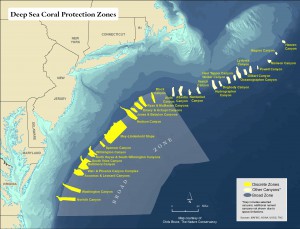On June 10, NCCOS’s cross-NOAA partnerships and investment in carrying out spatial analyses of deep-sea coral ecosystems informed a near-unanimous vote by the Mid-Atlantic Fishery Management Council (MAFMC) to protect more than 38,000 square miles of seafloor, stretching from New York to Virginia, from bottom fishing activities. NCCOS played a lead role producing statistical models of deep-sea coral habitat suitability, seafloor topographic analyses, a database of historical deep-sea coral presence locations, and guided an integrated field campaign to validate models and survey new coral habitats.
The detailed spatial information, in combination with the direct engagement of NOAA scientists at the invitation of stakeholders and Council staff, enabled NGO’s and fishing industry representatives to reach a broad consensus on proposed boundaries, leading to an outcome that both protects deep-sea corals and minimizes potential impacts to fisheries. The MAFMC designated fifteen discrete protection zones and a larger encompassing broad protection zone extending to the Exclusive Economic Zone, merging them into a single large protected area which is home to deep-sea coral as old as 1,000 years as well as a diverse community of fishes and invertebrates. This end-to-end transition of science through to an important conservation and management decision shows the value of researchin marine spatial planning processes, where more information can reveal opportunities to reduce conflict and create ‘win-win’ scenarios.

The MAFMC vote restricts nearly all bottom fishing in the protected area, with transit and enforcement provisions to minimize economic impacts to fisheries. This was the first use of discretionary authority granted to fishery Councils under the 2007 reauthorization of the Magnuson-Stevens Fisheries Conservation and Management Act to protect deep-sea corals purely for conservation and habitat protection reasons, rather than for any specific fishery management or sustainability goals. Key partners were the Northeast Fisheries Science Center, the Woods Hole Oceanographic Institution, NOAA’s Office of Ocean Exploration and Research, the Office of Coast Survey and NOAA’s Deep-Sea Coral Research and Technology Program.
For more information, contact Brian.Kinlan@noaa.gov
